HumanOLAT: A Large-Scale Dataset for Full-Body Human Relighting and Novel-View Synthesis
 |
|
Simultaneous relighting and novel-view rendering of digital human representations is an important yet challenging task with numerous applications. However, progress in this area has been significantly limited due to the lack of publicly available, high-quality datasets, especially for full-body human captures. To address this critical gap, we introduce the HumanOLAT dataset, the first publicly accessible large-scale dataset providing multi-view One-Light-at-a-Time (OLAT) captures of full-body humans. The dataset includes HDR RGB frames under various illumination conditions, such as white light, environment maps, color gradients and fine-grained OLAT illuminations. Our evaluations on state-of-the-art relighting and novel-view synthesis methods underscore both the dataset's value and the significant challenges still present in accurately modeling complex human-centric appearance and lighting interactions. We believe that HumanOLAT will significantly facilitate future research, enabling rigorous benchmarking and advancements in both general and human-specific relighting and rendering techniques.
|
Relightable Neural Actor with Intrinsic Decomposition and Pose Control
 |
|
Creating a controllable and relightable digital avatar from multi-view video with fixed illumination is a very challenging problem since humans are highly articulated, creating pose-dependent appearance effects, and skin as well as clothing require space-varying BRDF modeling. Existing works on creating animatible avatars either do not focus on relighting at all, require controlled illumination setups, or try to recover a relightable avatar from very low cost setups, i.e. a single RGB video, at the cost of severely limited result quality, e.g. shadows not even being modeled. To address this, we propose Relightable Neural Actor, a new video-based method for learning a pose-driven neural human model that can be relighted, allows appearance editing, and models pose-dependent effects such as wrinkles and self-shadows. Importantly, for training, our method solely requires a multi-view recording of the human under a known, but static lighting condition. To tackle this challenging problem, we leverage an implicit geometry representation of the actor with a drivable density field that models pose-dependent deformations and derive a dynamic mapping between 3D and UV spaces, where normal, visibility, and materials are effectively encoded. To evaluate our approach in real-world scenarios, we collect a new dataset with four identities recorded under different light conditions, indoors and outdoors, providing the first benchmark of its kind for human relighting, and demonstrating state-of-the-art relighting results for novel human poses.
|
MetaCap: Meta-learning Priors from Multi-View Imagery for Sparse-view Human Performance Capture and Rendering
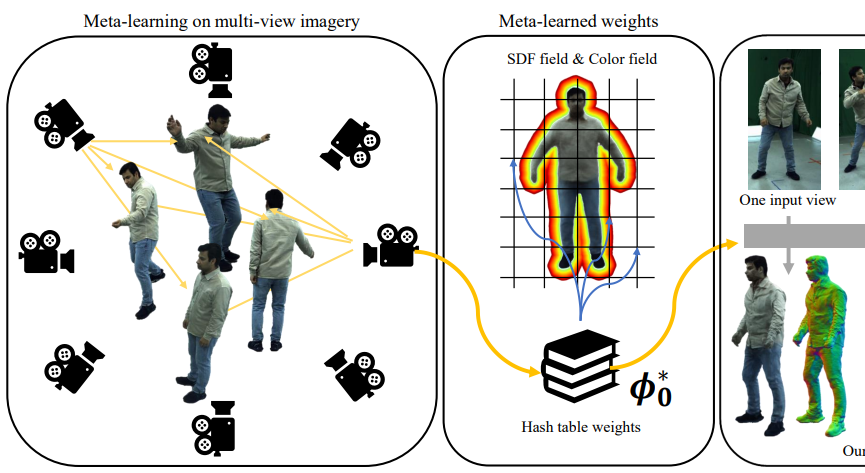 |
|
Faithful human performance capture and free-view render- ing from sparse RGB observations is a long-standing problem in Vision and Graphics. The main challenges are the lack of observations and the inherent ambiguities of the setting, e.g. occlusions and depth ambiguity. As a result, radiance fields, which have shown great promise in capturing high-frequency appearance and geometry details in dense setups, perform poorly when naïvely supervising them on sparse camera views, as the field simply overfits to the sparse-view inputs. To address this, we propose MetaCap, a method for efficient and high-quality geometry recovery and novel view synthesis given very sparse or even a single view of the human. Our key idea is to meta-learn the radiance field weights solely from potentially sparse multi-view videos, which can serve as a prior when fine-tuning them on sparse imagery depicting the human. This prior provides a good network weight initialization, thereby effectively addressing ambiguities in sparse-view capture. Due to the articulated structure of the human body and motion-induced surface deformations, learning such a prior is non-trivial. Therefore, we propose to meta-learn the field weights in a pose-canonicalized space, which reduces the spatial feature range and makes feature learning more effective. Consequently, one can fine-tune our field parameters to quickly generalize to unseen poses, novel illumination conditions as well as novel and sparse (even monocular) camera views. For evaluating our method under different scenarios, we collect a new dataset, WildDynaCap, which contains subjects captured in, both, a dense camera dome and in-the-wild sparse camera rigs, and demonstrate superior results compared to recent state-of-the-art methods on both public and WildDynaCap dataset.
|
ASH: Animatable Gaussian Splats for Efficient and Photoreal Human Rendering
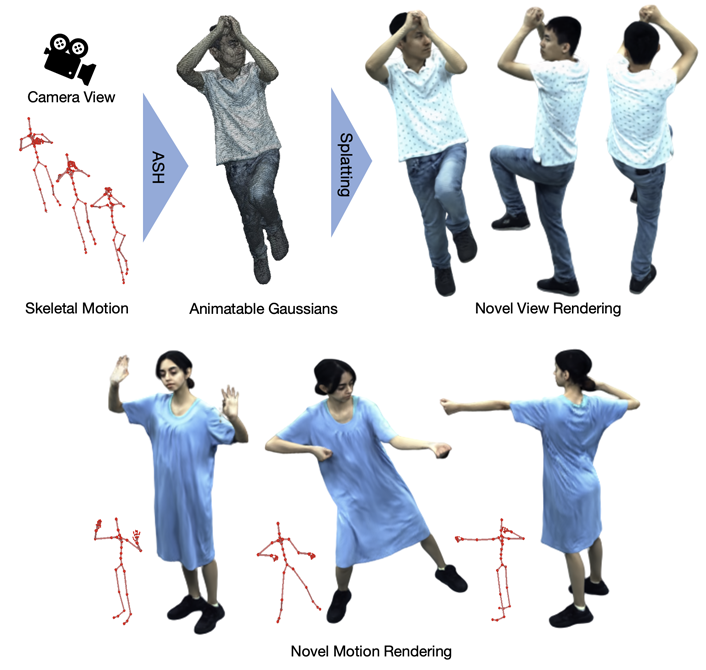 |
|
Real-time rendering of photorealistic and controllable human avatars stands as a cornerstone in Computer Vision and Graphics. While recent advances in neural implicit rendering have unlocked unprecedented photorealism for digital avatars, real-time performance has mostly been demonstrated for static scenes only. To address this, we propose ASH, an Animatable Gaussian Splatting approach for photorealistic rendering of dynamic Humans in real time. We parameterize the clothed human as animatable 3D Gaussians, which can be efficiently splatted into image space to generate the final rendering. However, naively learning the Gaussian parameters in 3D space poses a severe challenge in terms of compute. Instead, we attach the Gaussians onto a deformable character model, and learn their parameters in 2D texture space, which allows leveraging efficient 2D convolutional architectures that easily scale with the required number of Gaussians. We benchmark ASH with competing methods on pose-controllable avatars, demonstrating that our method outperforms existing real-time methods by a large margin and shows comparable or even better results than offline methods.
|
Holoported Characters: Real-time Free-viewpoint Rendering of Humans from Sparse RGB Cameras
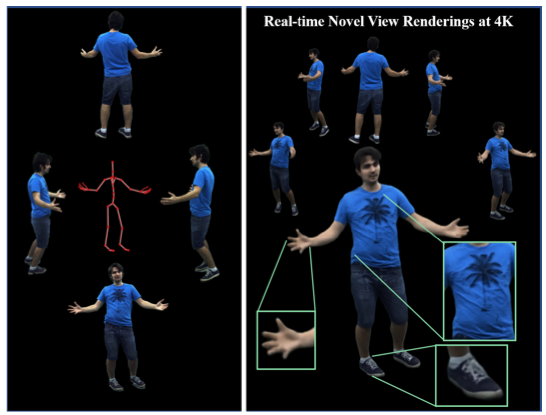 |
|
We present the first approach to render highly realistic free-viewpoint videos of a human actor in general apparel, from sparse multi-view recording to display, in real-time at an unprecedented 4K resolution. At inference, our method only requires four camera views of the moving actor and the respective 3D skeletal pose. It handles actors in wide clothing, and reproduces even fine-scale dynamic detail, e.g. clothing wrinkles, face expressions, and hand gestures. At training time, our learning-based approach expects dense multi-view video and a rigged static surface scan of the actor. Our method comprises three main stages. Stage 1 is a skeleton-driven neural approach for high-quality capture of the detailed dynamic mesh geometry. Stage 2 is a novel solution to create a view-dependent texture using four test-time camera views as input. Finally, stage 3 comprises a new image-based refinement network rendering the final 4K image given the output from the previous stages. Our approach establishes a new benchmark for real-time rendering resolution and quality using sparse input camera views, unlocking possibilities for immersive telepresence.
|
Neural Actor: Neural Free-view Synthesis of Human Actors with Pose Control
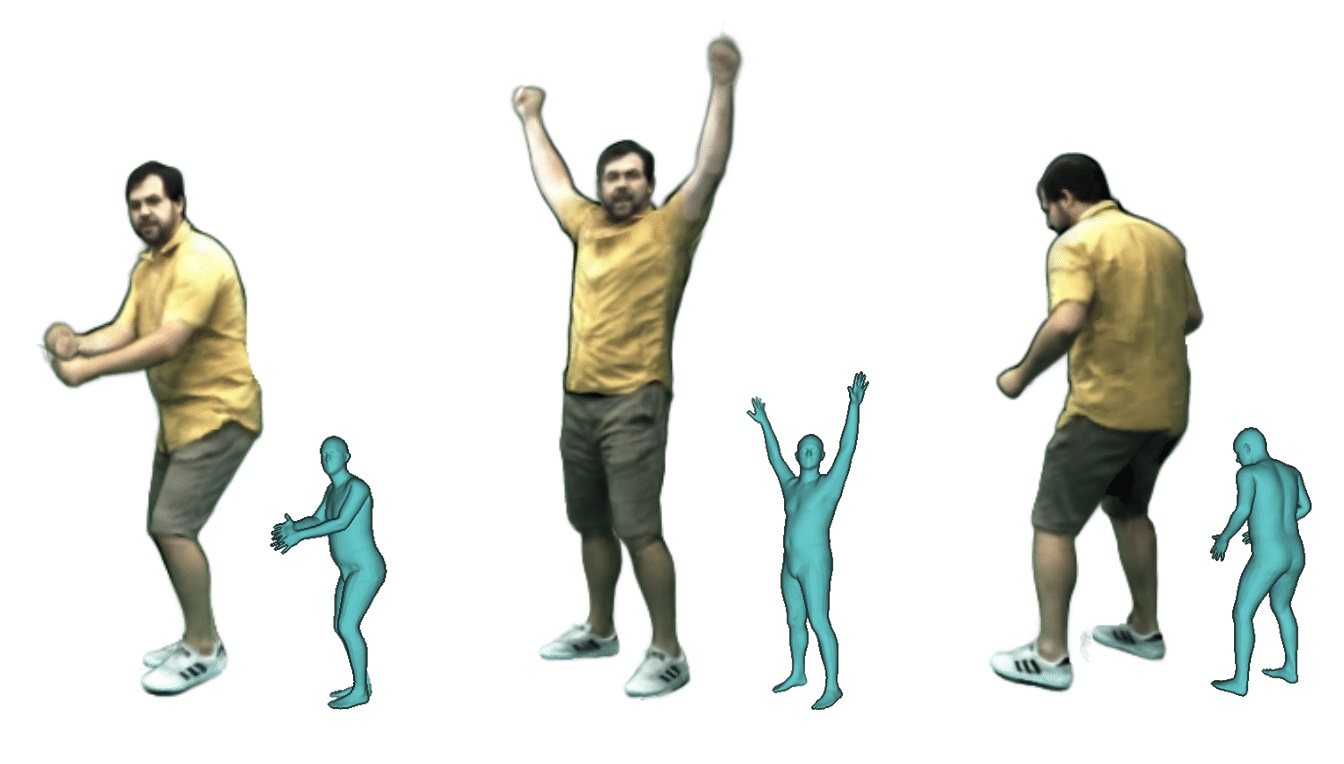 |
|
We propose Neural Actor (NA), a new method for high-quality synthesis of humans from arbitrary viewpoints and under arbitrary controllable poses. Our method is built upon recent neural scene representation and rendering works which learn representations of geometry and appearance from only 2D images. While existing works demonstrated compelling rendering of static scenes and playback of dynamic scenes, photo-realistic reconstruction and rendering of humans with neural implicit methods, in particular under user-controlled novel poses, is still difficult. To address this problem, we utilize a coarse body model as the proxy to unwarp the surrounding 3D space into a canonical pose. A neural radiance field learns pose-dependent geometric deformations and pose- and view-dependent appearance effects in the canonical space from multi-view video input. To synthesize novel views of high fidelity dynamic geometry and appearance, we leverage 2D texture maps defined on the body model as latent variables for predicting residual deformations and the dynamic appearance. Experiments demonstrate that our method achieves better quality than the state-of-the-arts on playback as well as novel pose synthesis, and can even generalize well to new poses that starkly differ from the training poses. Furthermore, our method also supports body shape control of the synthesized results.
|
NeRF-OSR: Neural Radiance Fields for Outdoor Scene Relighting
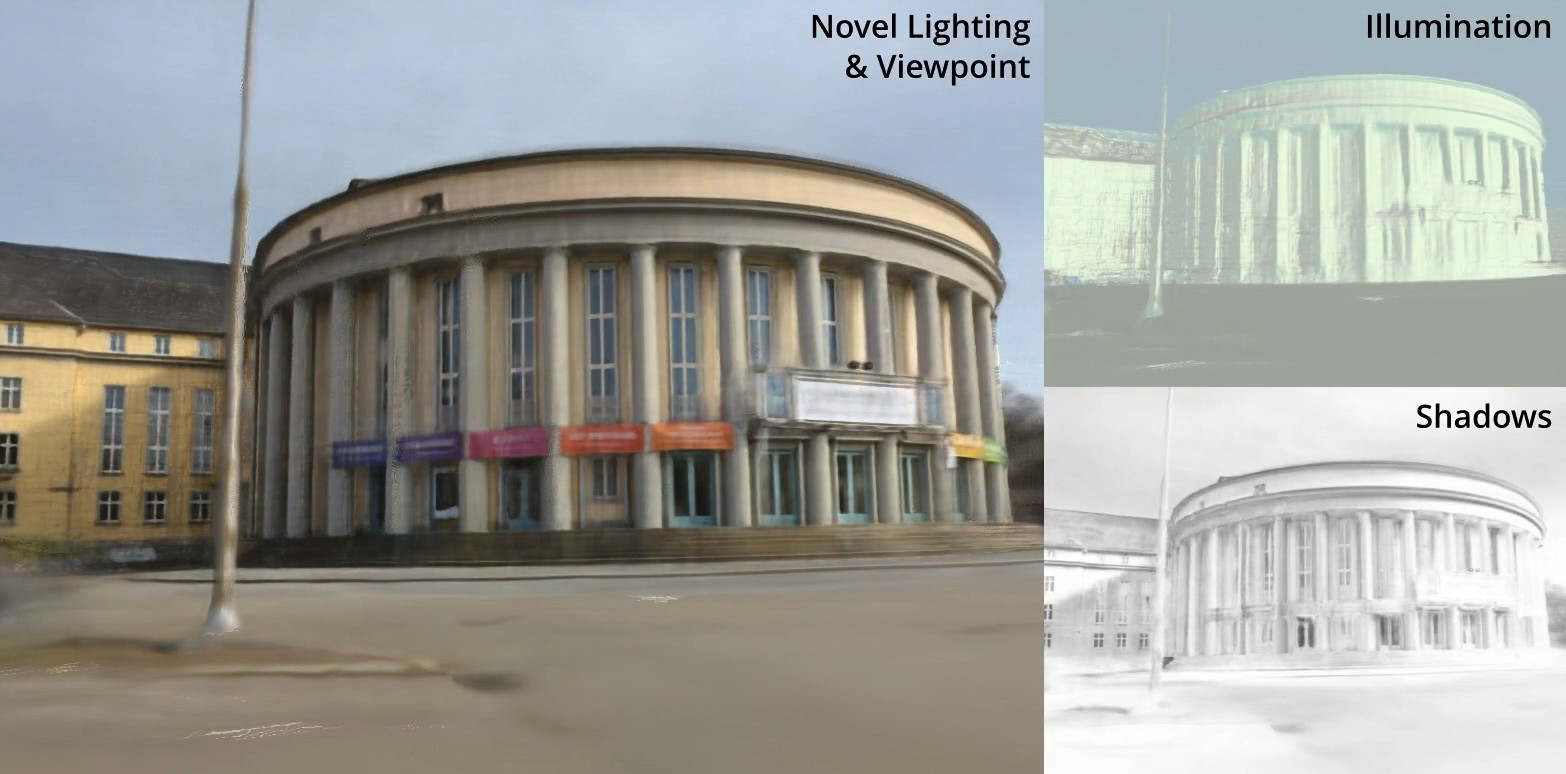 |
|
Photorealistic editing of outdoor scenes from photographs requires a profound understanding of the image formation process and an accurate estimation of the scene geometry, reflectance and illumination. A delicate manipulation of the lighting can then be performed while keeping the scene albedo and geometry unaltered. We present NeRF-OSR, i.e., the first approach for outdoor scene relighting based on neural radiance fields. In contrast to the prior art, our technique allows simultaneous editing of both scene illumination and camera viewpoint using only a collection of outdoor photos shot in uncontrolled settings. Moreover, it enables direct control over the scene illumination, as defined through a spherical harmonics model. It also includes a dedicated network for shadow reproduction, which is crucial for high-quality outdoor scene relighting. To evaluate the proposed method, we collect a new benchmark dataset of several outdoor sites, where each site is photographed from multiple viewpoints and at different timings. For each timing, a 360° environment map is captured together with a colour-calibration chequerboard to allow accurate numerical evaluations on real data against ground truth. Comparisons against state of the art show that NeRF-OSR enables controllable light and viewpoint editing at higher quality and with realistic self-shadowing reproduction.
|
EventHands: Real-Time Neural 3D Hand Reconstruction from an Event Stream
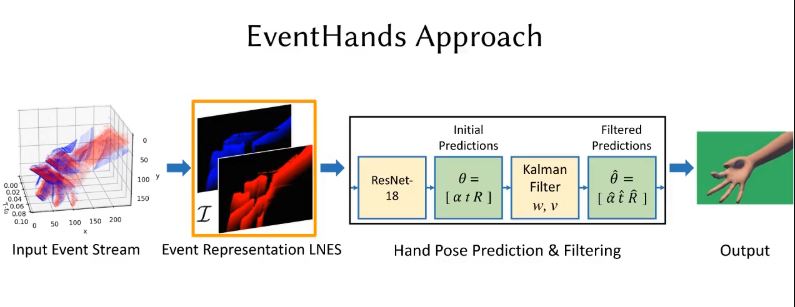 |
|
3D hand pose estimation from monocular videos is a long-standing and challenging problem, which is now seeing a strong upturn. In this work, we address it for the first time using a single event camera, i.e., an asynchronous vision sensor reacting on brightness changes. Our EventHands approach has characteristics previously not demonstrated with a single RGB or depth camera such as high temporal resolution at low data throughputs and real-time performance at 1000 Hz. Due to the different data modality of event cameras compared to classical cameras, existing methods cannot be directly applied to and re-trained for event streams. We thus design a new neural approach which accepts a new event stream representation suitable for learning, which is trained on newly-generated synthetic event streams and can generalise to real data. Experiments show that EventHands outperforms recent monocular methods using a colour (or depth) camera in terms of accuracy and its ability to capture hand motions of unprecedented speed. Our method, the event stream simulator and the dataset will be made publicly available.
|
PhysCap: Physically Plausible Monocular 3D Motion Capture in Real Time
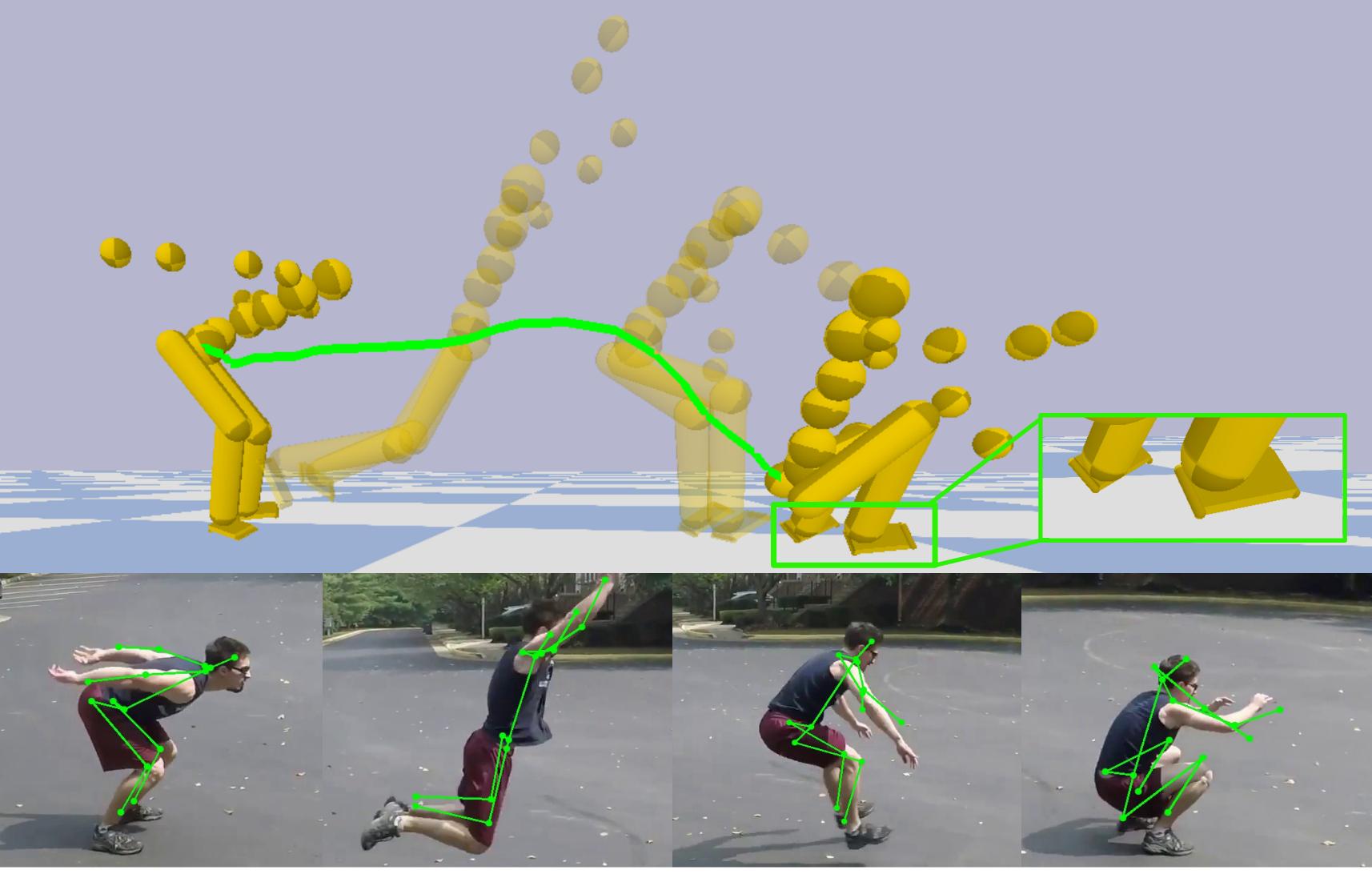 |
|
Marker-less 3D human motion capture from a single colour camera has seen significant progress. However, captured 3D poses are often physically incorrect and biomechanically implausible, or exhibit implausible environment interactions (floor penetration, foot skating, unnatural body leaning and strong shifting in depth), which is problematic for any use case in computer graphics. We, therefore, present PhysCap, the first algorithm for physically plausible marker-less human 3D motion capture with a single colour camera.
|
Phi-SfT: Shape-from-Template with a Physics-Based Deformation Model
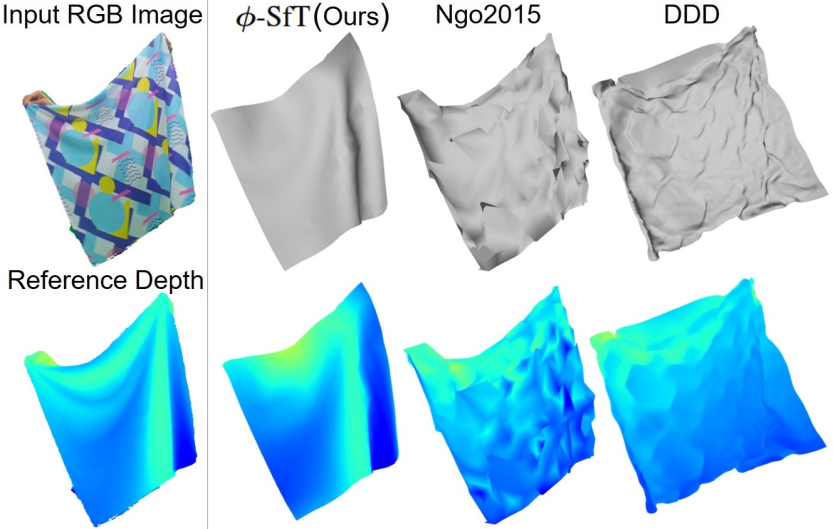 |
|
Shape-from-Template (SfT) methods estimate 3D surface deformations from a single monocular RGB camera while assuming a 3D state known in advance (a template). This is an important yet challenging problem due to the underconstrained nature of the monocular setting. Existing SfT techniques predominantly use geometric and simplified deformation models, which often limits their reconstruction abilities. In contrast to previous works, this paper proposes a new SfT approach explaining 2D observations through physical simulations accounting for forces and material properties. Our differentiable physics simulator regularises the surface evolution and optimises the material elastic properties such as bending coefficients, stretching stiffness and density. We use a differentiable renderer to minimise the dense reprojection error between the estimated 3D states and the input images and recover the deformation parameters using an adaptive gradient-based optimisation. For the evaluation, we record with an RGB-D camera challenging real surfaces exposed to physical forces with various material properties and textures. Our approach significantly reduces the 3D reconstruction error compared to multiple competing methods.
|
DeepCap: Monocular Human Performance Capture Using Weak Supervision
 |
|
Human performance capture is a highly important computer vision problem with many applications in movie production and virtual/augmented reality. Many previous performance capture approaches either required expensive multi-view setups or did not recover dense space-time coherent geometry with frame-to-frame correspondences. We propose a novel deep learning approach for monocular dense human performance capture. Our method is trained in a weakly supervised manner based on multi-view supervision completely removing the need for training data with 3D ground truth annotations. The network architecture is based on two separate networks that disentangle the task into a pose estimation and a non-rigid surface deformation step. Extensive qualitative and quantitative evaluations show that our approach outperforms the state of the art in terms of quality and robustness.
|
Real-time Deep Dynamic Characters
 |
|
We propose a deep videorealistic 3D human character model displaying highly realistic shape, motion, and dynamic appearance learned in a new weakly supervised way from multi-view imagery. In contrast to previous work, our controllable 3D character displays dynamics, e.g., the swing of the skirt, dependent on skeletal body motion in an efficient data-driven way, without requiring complex physics simulation. Our character model also features a learned dynamic texture model that accounts for photo-realistic motion-dependent appearance details, as well as view-dependent lighting effects. During training, we do not need to resort to difficult dynamic 3D capture of the human; instead we can train our model entirely from multi-view video in a weakly supervised manner. To this end, we propose a parametric and differentiable character representation which allows us to model coarse and fine dynamic deformations, e.g., garment wrinkles, as explicit space-time coherent mesh geometry that is augmented with high-quality dynamic textures dependent on motion and view point. As input to the model, only an arbitrary 3D skeleton motion is required, making it directly compatible with the established 3D animation pipeline. We use a novel graph convolutional network architecture to enable motion-dependent deformation learning of body and clothing, including dynamics, and a neural generative dynamic texture model creates corresponding dynamic texture maps. We show that by merely providing new skeletal motions, our model creates motion-dependent surface deformations, physically plausible dynamic clothing deformations, as well as video-realistic surface textures at a much higher level of detail than previous state of the art approaches, and even in real-time.
|
i3DMM: Deep Implicit 3D Morphable Model of Human Heads
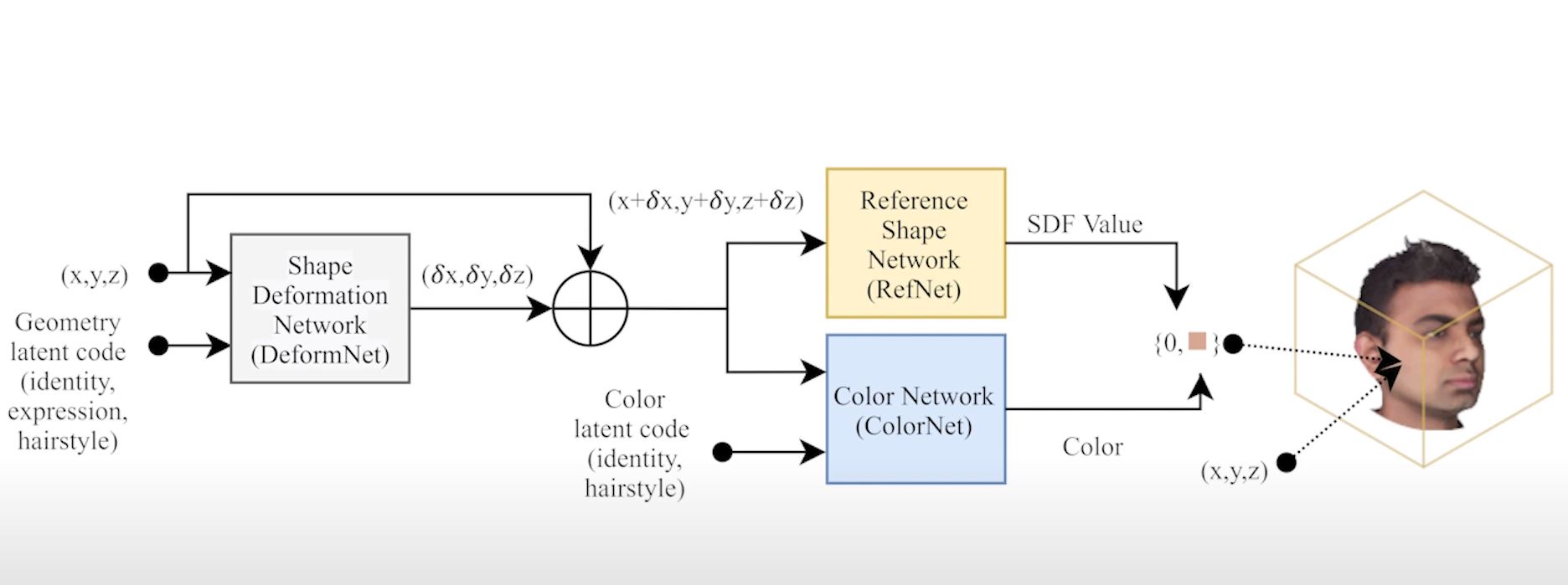 |
|
We present the first deep implicit 3D morphable model (i3DMM) of full heads. Unlike earlier morphable face models it not only captures identity-specific geometry, texture, and expressions of the frontal face, but also models the entire head, including hair. We collect a new dataset consisting of 64 people with different expressions and hairstyles to train i3DMM. Our approach has the following favorable properties: (i) It is the first full head morphable model that includes hair. (ii) In contrast to mesh-based models it can be trained on merely rigidly aligned scans, without requiring difficult non-rigid registration. (iii) We design a novel architecture to decouple the shape model into an implicit reference shape and a deformation of this reference shape. With that, dense correspondences between shapes can be learned implicitly. (iv) This architecture allows us to semantically disentangle the geometry and color components, as color is learned in the reference space. Geometry is further disentangled as identity, expressions, and hairstyle, while color is disentangled as identity and hairstyle components. We show the merits of i3DMM using ablation studies, comparisons to state-of-the-art models, and applications such as semantic head editing and texture transfer. We will make our model publicly available.
|
LiveCap: Real-time Human Performance Capture from Monocular Video
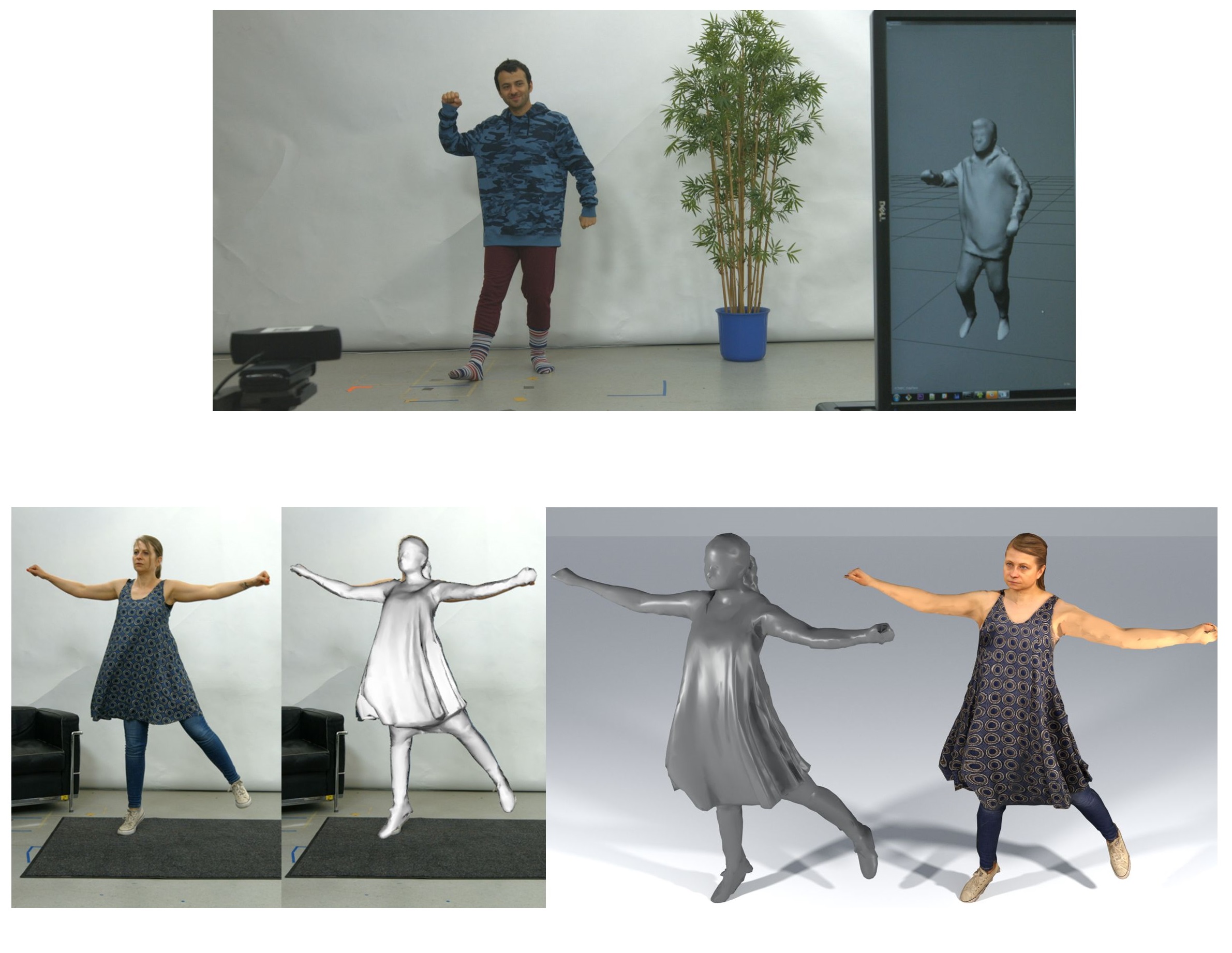 |
|
We present the first real-time human performance capture approach that reconstructs dense, space-time coherent deforming geometry of entire humans in general everyday clothing from just a single RGB video.We propose a novel two-stage analysis-by-synthesis optimization whose formulation and implementation are designed for high performance. In the first stage, a skinned template model is jointly fitted to background subtracted input video, 2D and 3D skeleton joint positions found using a deep neural network, and a set of sparse facial landmark detections. In the second stage, dense non-rigid 3D deformations of skin and even loose apparel are captured based on a novel real-time capable algorithm for non-rigid tracking using dense photometric and silhouette constraints. Our novel energy formulation leverages automatically identified material regions on the template to model the differing non-rigid deformation behavior of skin and apparel. The two resulting nonlinear optimization problems per-frame are solved with specially-tailored data-parallel Gauss-Newton solvers. In order to achieve real-time performance of over 25Hz, we design a pipelined parallel architecture using the CPU and two commodity GPUs. Our method is the first real-time monocular approach for full-body performance capture. Our method yields comparable accuracy with off-line performance capture techniques, while being orders of magnitude faster.
|
NRSfM: Neural Dense Non-Rigid Structure from Motion
with Latent Space Constraints
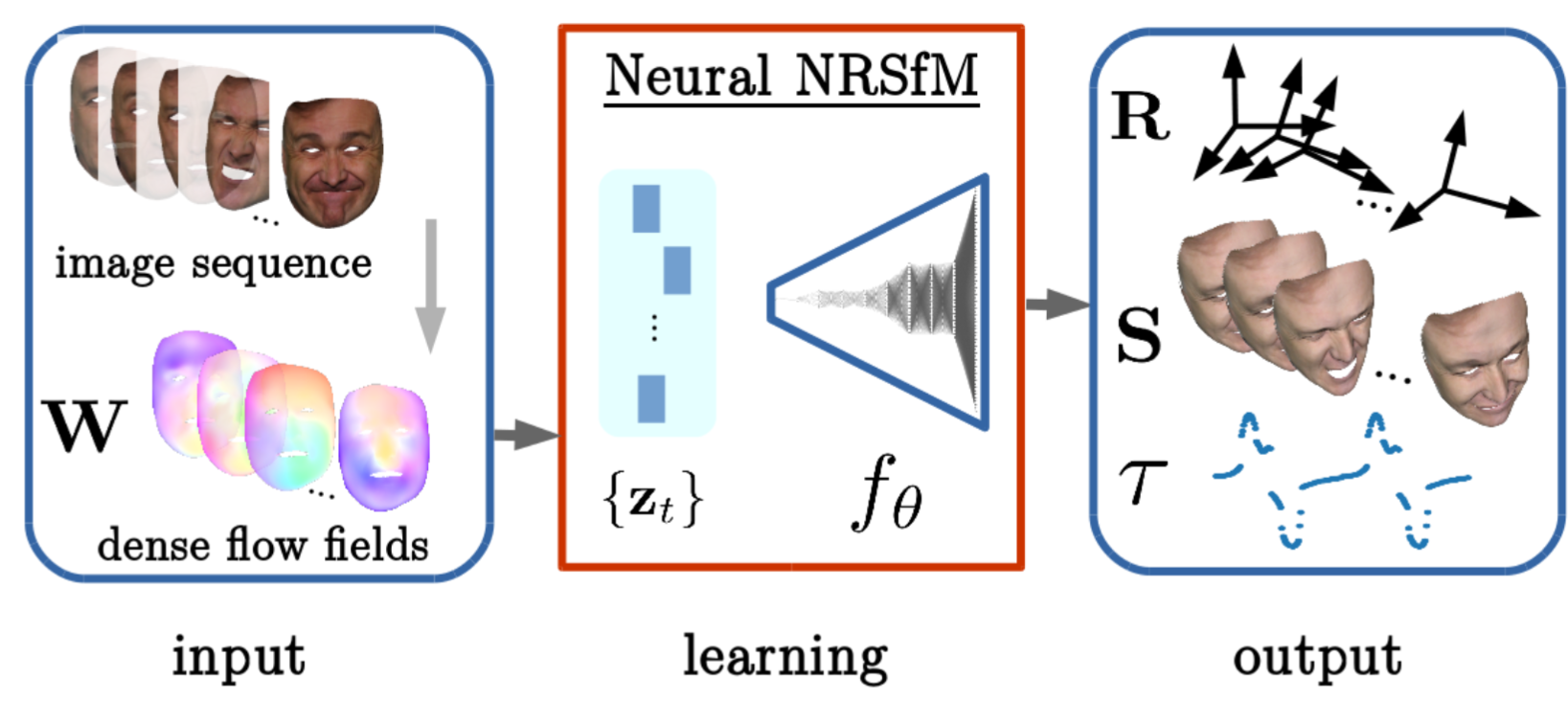 |
|
We introduce the first dense neural non-rigid structure from motion (N-NRSfM) approach, which can be trained end-to-end in an unsupervised manner from 2D point tracks. Compared to the competing methods, our combination of loss functions is fully-differentiable and can be readily integrated into deep-learning systems. We formulate the deformation model by an auto-decoder and impose subspace constraints on the recovered latent space function in a frequency domain. Thanks to the state recurrence cue, we classify the reconstructed non-rigid surfaces based on their similarity and recover the period of the input sequence. Our N-NRSfM approach achieves competitive accuracy on widely-used benchmark sequences and high visual quality on various real videos. Apart from being a standalone technique, our method enables multiple applications including shape compression, completion and interpolation, among others. Combined with an encoder trained directly on 2D images, we perform scenario-specific monocular 3D shape reconstruction at interactive frame rates. To facilitate the reproducibility of the results and boost the new research direction, we open-source our code and provide trained models for research purposes.
|
HTML: A Parametric Hand Texture Model for 3D Hand Reconstruction and Personalization
 |
|
3D hand reconstruction from images is a widely-studied problem in computer vision and graphics, and has a particularly high relevance for virtual and augmented reality. Although several 3D hand reconstruction approaches leverage hand models as a strong prior to resolve ambiguities and achieve more robust results, most existing models account only for the hand shape and poses and do not model the texture. To fill this gap, in this work we present HTML, the first parametric texture model of human hands. Our model spans several dimensions of hand appearance variability (e.g., related to gender, ethnicity, or age) and only requires a commodity camera for data acquisition. Experimentally, we demonstrate that our appearance model can be used to tackle a range of challenging problems such as 3D hand reconstruction from a single monocular image. Furthermore, our appearance model can be used to define a neural rendering layer that enables training with a self-upervised photometric loss. We make our model publicly available.
|
XNect: Real-time Multi-Person 3D Motion Capture with a Single RGB
Camera
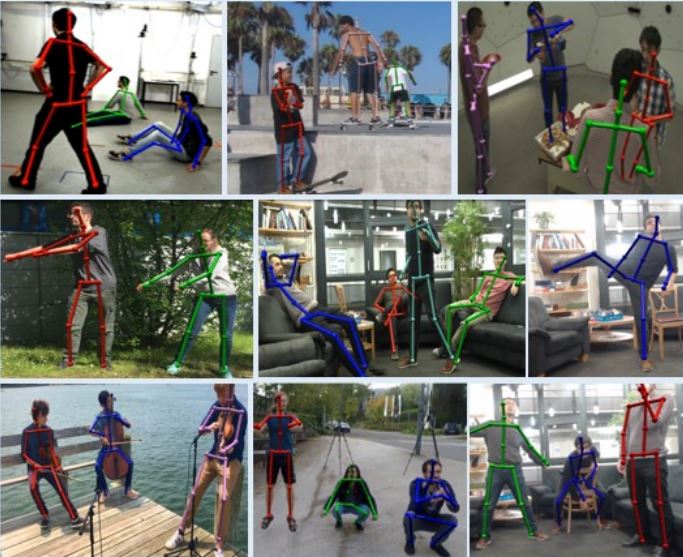 |
|
We present a real-time approach for multi-person 3D motion capture at over 30 fps using a single RGB camera. It operates successfully in generic scenes which may contain occlusions by objects and by other people. Our method operates in subsequent stages. The first stage is a convolutional neural network (CNN) that estimates 2D and 3D pose features along with identity assignments for all visible joints of all individuals.We contribute a new architecture for this CNN, called SelecSLS Net, that uses novel selective long and short range skip connections to improve the information flow allowing for a drastically faster network without compromising accuracy. In the second stage, a fully connected neural network turns the possibly partial (on account of occlusion) 2Dpose and 3Dpose features for each subject into a complete 3Dpose estimate per individual. The third stage applies space-time skeletal model fitting to the predicted 2D and 3D pose per subject to further reconcile the 2D and 3D pose, and enforce temporal coherence. Our method returns the full skeletal pose in joint angles for each subject. This is a further key distinction from previous work that do not produce joint angle results of a coherent skeleton in real time for multi-person scenes. The proposed system runs on consumer hardware at a previously unseen speed of more than 30 fps given 512x320 images as input while achieving state-of-the-art accuracy, which we will demonstrate on a range of challenging real-world scenes.
|
IsMo-GAN: Adversarial Learning for Monocular Non-Rigid 3D Reconstruction
 |
|
The majority of the existing methods for non-rigid 3D surface regression from monocular 2D images require an object template or point tracks over multiple frames as an
input, and are still far from real-time processing rates. In this work, we present the Isometry-Aware Monocular Generative Adversarial Network (IsMo-GAN) — an approach
for direct 3D reconstruction from a single image, trained for the deformation model in an adversarial manner on a light-weight synthetic dataset. IsMo-GAN reconstructs surfaces from real images under varying illumination, camera poses, textures and shading at over 250 Hz. In multiple experiments, it consistently outperforms several approaches
in the reconstruction accuracy, runtime, generalisation to unknown surfaces and robustness to occlusions. In comparison to the state-of-the-art, we reduce the reconstruction
error by 10-30% including the textureless case and our surfaces evince fewer artefacts qualitatively.
|
DispVoxNets: Non-Rigid Point Set Alignment
with Supervised Learning Proxies
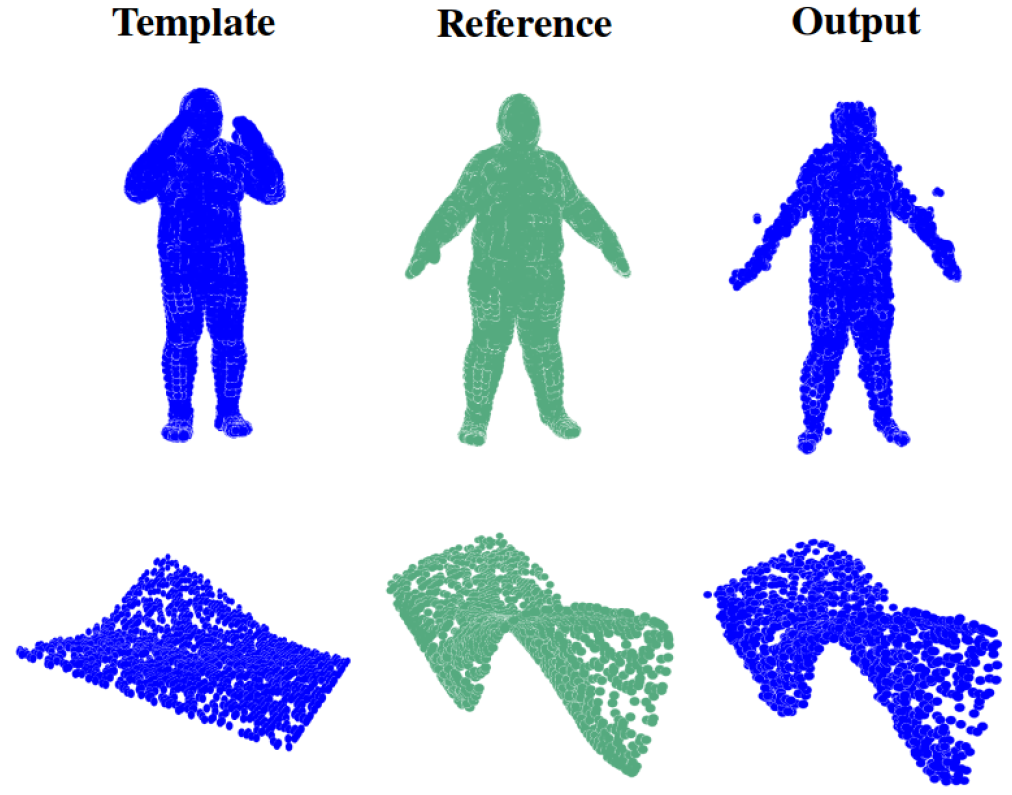 |
|
A supervised-learning framework for non-rigid point set alignment of a new kind — Displacements on Voxels Networks (DispVoxNets) — which abstracts away from the point set representation and regresses 3D displacement fields on regularly sampled proxy 3D voxel grids. Thanks to recently released collections of deformable objects with known intra-state correspondences, DispVoxNets learn a deformation model and further priors (e.g., weak point topology preservation) for different object categories such as cloths, human bodies and faces. DispVoxNets cope with large deformations, noise and clustered outliers more robustly than the state-of-the-art. At test time, our approach runs orders of magnitude faster than previous techniques.
|
VNect: Real-time 3D Human Pose Estimation with a Single RGB Camera
 |
|
The first real-time method to capture the full global 3D skeletal pose of a human in a stable, temporally consistent manner using a single RGB camera. Our method combines a new convolutional neural network (CNN) based pose regressor with kinematic skeleton fitting. Our novel fully-convolutional pose formulation regresses 2D and 3D joint positions jointly in real time and does not require tightly cropped input frames. A real-time kinematic skeleton fitting method uses the CNN output to yield temporally stable 3D global pose reconstructions on the basis of a coherent kinematic skeleton. This makes our approach the first monocular RGB method usable in real-time applications such as 3D character control---thus far, the only monocular methods for such applications employed specialized RGB-D cameras. Our method's accuracy is quantitatively on par with the best offline 3D monocular RGB pose estimation methods. Our results are qualitatively comparable to, and sometimes better than, results from monocular RGB-D approaches, such as the Kinect. However, we show that our approach is more broadly applicable than RGB-D solutions, i.e., it works for outdoor scenes, community videos, and low quality commodity RGB cameras.
|
GANerated Hands for Real-Time 3D Hand Tracking from Monocular RGB
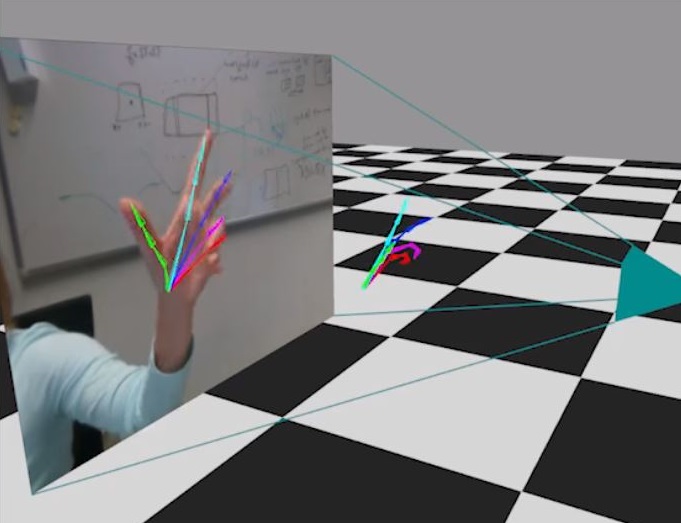 |
|
A real-time 3D hand tracking based on a monocular RGB-only sequence. Our tracking method combines a convolutional neural network with a kinematic 3D hand model, such that it generalizes well to unseen data, is robust to occlusions and varying camera viewpoints, and leads to anatomically plausible as well as temporally smooth hand motions. For training our CNN we propose a novel approach for the synthetic generation of training data that is based on a geometrically consistent image-to-image translation network. To be more specific, we use a neural network that translates synthetic images to “real” images, such that the so-generated images follow the same statistical distribution as real-world hand images. For training this translation network we combine an adversarial loss and a cycle-consistency loss with a geometric consistency loss in order to preserve geometric properties (such as hand pose) during translation. We demonstrate that our hand tracking system outperforms the current state-of-the-art on challenging RGB-only footage.
|
| | | | | | | | | | | | | | | | | | | |




















